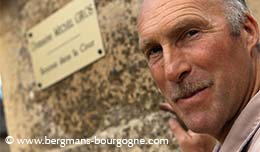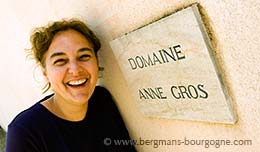
eing a winegrower has not always been the obvious choice for Emmanuel Giboulot in Beaune. As a student he was geared towards the stage, not the vineyards.
– At the time it was not the obvious choice for me, he explains. When I was at school I was more interested in the theatre, interested in becoming an actor.
Today, a couple of decades down the road, Domaine Emmanuel Giboulot covers ten hectares – from the Rully premier cru La Pucelle down in the Côte Chalonnaise up to the Hautes-Côtes de Nuits. Emmanuel Giboulot himself has become one of the prominent figures in organic winegrowing in Burgundy. He is a member of the global network Renaissance des Appellations/Return to Terroir that was founded in 2001 by Nicolas Joly at the Coulée de Serrant in the Loire.
Emmanuel Giboulot is at the Grand Hotel in Stockholm. He has just finished seven hours at a wine fair in the Swedish capital organized by the Return to Terroir group. On this particular day he is the only Burgundian winegrower present, but he has been kept company by 58 other organic winegrowers from around the world.
 – These events are interesting because they give us an opportunity to show the customers in a country what different winegrowers, who all work organically, from around the world can do, Emmanuel Giboulot says. When it comes to wine-making we exchange experiences, but not so much at these events; that's more when we meet in smaller groups. At these wine fairs there is usually very little time for such things.
– These events are interesting because they give us an opportunity to show the customers in a country what different winegrowers, who all work organically, from around the world can do, Emmanuel Giboulot says. When it comes to wine-making we exchange experiences, but not so much at these events; that's more when we meet in smaller groups. At these wine fairs there is usually very little time for such things.
It was back in 1985 that Emmanuel Giboulot set out on his own. Creating a new domaine in Burgundy is not easy. Land is expensive and availability scarce. So his first vineyards covered a mere 0,8 hectares. In addition he had nine hectares for other crops.
– What also made it difficult was that I lived in a village five six kilometres from Beaune, a village that was not a wine village. And the people who had vines to let were more suspicious if you were working organically.

– In 1991 I took on 38 ares of Beaune. In 1993 I added 22 ares of Rully and 1,5 hectares of Hautes-Côtes de Nuits. It took me ten years to complete.
– For my father the vines were only a small part of his activity. He was mainly a farmer and he only had five hectares of vines. These were all located east of Beaune, so they were in the regional appellation Bourgogne.
It was from his father that he inherited his interest for working organically. His father was an early adapter to organic farming, starting already in the 1970's.
– When he began he was more or less alone, says Emmanuel Giboulot. None of his neighbours would be working the same way. Today you have colleagues that work along biodynamic principles, even though their parcels may not necessarily be directly neighbouring yours. Take the Beaune vignoble for example; about ten percent of the surface is being worked organically. It's not ideal, but it's not bad either. The important thing is to have the progress.
Emmanuel Giboulot has been using organic practices ever since he set out in 1985. In 1996 he applied the stricter principles for biodynamic farming. He ploughs the vineyards and harvest is done manually. Organic composts are used to stimulate the natural microbiological life of the soil.

If the neighbouring vines are not farmed according to organic principles it is of course not the ideal situation. But Emmanuel Giboulot points out that perfect conditions are impossible to find, but that the important thing is to always strive for improvements.
– Unfortunately no one is completely protected, he says. Even if I would be all alone with my vines I would not be protected from the air or from the rain that falls. But there are many things you can do to improve things such as the vines resisitance to parasites, the quality of the soil etc.
Three of Emmanuel Giboulot's wines come from the obscure appellation Côte de Beaune that should not be confused with Côte de Beaune-Villages, the appellation which covers the villages of Auxey-Duresses, Blagny, Chassagne-Montrachet, Chorey-lès-Beaune, Ladoix-Serrigny, Meursault, Monthélie, Pernand-Vergelesses, Puligny-Montrachet, Saint-Aubin, Saint-Romain, Santenay and Savigny-lès-Beaune.
The Côte de Beaune appellation is uphill from the Beaune vineyards, but not so far up so it becomes Hautes-Côtes de Beaune. It is a small appellation with no premier crus, only covering 33,40 hectares (the Beaune vinyards cover 407 hectares). All three of Giboulot's Côte de Beaune wines – Combe d'Eve, Les Pierres Blanches and La Grande Chatelaine – frequently receive very good reviews.
– It is an appellation for both red and white wine, explains Emmanuel Giboulot. It is not very well known or seen very often on the market. I find it very interesting, but you have to spend a lot of time explaining to people what it is. It is not Meursault, which is something people know exactly what it is.
© 2008 Ola Bergman














